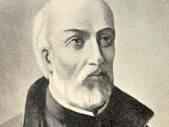
Feast day: 19 October
St Jean Brébeuf was born in Condé sur Vire, Normandy, France, on 25 March 1593. He joined the Society of Jesus when he was 24. Between 1619 and 1621 he was a teacher at the college in Rouen. He was nearly expelled from the order when he contracted tuberculosis, which interfered with his studying and teaching. He was not particularly distinguished as a student but he had an aptitude for languages. He had entered the order as a brother but his superior encouraged him to become a priest, so he was ordained in Pontoise Cathedral in February 1622. After three years as Steward at the College in Rouen, Jean Brébeuf was chosen by the French Provincial for the mission in New France.
Jean arrived in Québec together with Fathers Charles Lalemant and Énemod Massé together with lay brothers Francois Charton and Gilbert Burel. He worked at the Sainte Marie among the Hurons. For about five months he lived with a tribe on Montagnais, who spoke an Algonquian language. He was later assigned to the Huron with another priest. From then on he worked mostly as a missionary to the Huron who spoke an Iroquoian language. He briefly took up residence with the Bear Tribe at Toanché but was unable to convert them to Catholicism. He was summoned to Québec because the colony was threatened by the English. In 1629 Samuel de Champlain, who was virtual governor of the colony, surrendered and the missionaries returned to France.
In France Jean served as a preacher and confessor, taking his final Jesuit vows in 1630. Between 1631 amd 1633 he worked at the College of Eu, Seine-Maritime, in northern France as a steward, minister and confessor. He returned to New France in 1633, which had been restored to France, and lived there for the rest of his life. He worked with the Huron people along with two other missionaries. The Hurons suffered epidemics of diseases that they caught from the Europeans and with no immunity they died in great numbers. This caused suspicion of the Europeans, who they felt had infected them.
Jean learnt their language, which he taught to other missionaries. He was named Échon by the tribe, which means “the strong one” or “the one that carries the load.” This was because after canoeing with the Hurons he had carried the boat where necessary. He was a big man and the Hurons had been afraid he would sink their loaded canoe. From his growing friendship with the Indians he learnt about their culture and spirituality. His efforts to develop a complete ethnographic record of the Hurons has been described as the “longest and most ambitious piece of ethnographic description in all the Jesuit relations.” He produced a catechism in the Huron language and a grammar. He is also credited with writing the Huron Carol, Canada’s oldest Christmas song, written in 1642. He also wrote a detailed account of the “Huron Feast of the Dead”, a mass reburial of loved ones after the community moved the location of its village, the ceremony being accompanied by elaborate ritual and gift giving.
The Jesuit missionaries found it difficult to learn native languages as they were educated in the classics. Jean, however, seems to have really mastered the nuances of the Huron tongue with its metaphor, circumlocution and repetition. He had difficulty in the beginning with converting the Indians but as his knowledge of their language and culture grew he became more successful.
In 1638 Jean turned over the direction of the mission at St Joseph I to Lalemant, as he had been called to be superior of the newly-founded St Joseph II. In 1640 after an unsuccessful mission into the Neutral Nation territory he broke his collar bone. He was sent to Québec to recover and worked there. He taught the Huron and acted as confessor to the Ursulines and Religious Hospitallers. On Sundays and feast-days he preached to French colonists.
He continued his mission with the Hurons. They and the Iroquois tribe were bitter enemies because they competed over the fur trade. In 1649 the Huron mission village at St Louis was destroyed by the Iroquois and Jean and Gabriel Lalemant were taken to St Ignace, where they were cruelly, ritually tortured and killed. Other Jesuits were brutally murdered. The Iroquois ate Jean’s heart and drank his blood because they wanted to capture for themselves the courage with which he endured his pain. Throughout the ordeal, Jean was more concerned for his fellow Jesuits and the native converts than he was for himself. Accounts were produced of the two deaths from reports given by Hurons who had escaped. The body of Jean Brébeuf and Lalemant were recovered and buried in a Sainte Marie cemetery.
Jean Brébeuf and eight other martyred Jesuits were canonised by Pope Pius XI in 1930.
St Jean Brébeuf, martyr of the Society of Jesus, pray for us.